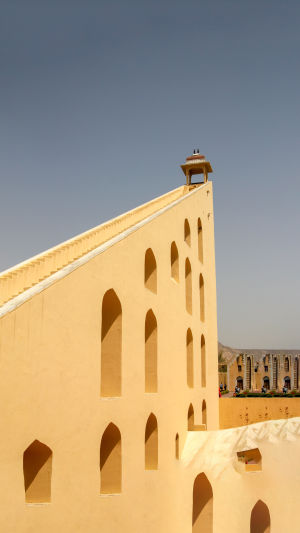Jantar Mantar in Jaipur, India, is a fascinating marvel of science, art, and heritage. Built in the early 18th century by Maharaja Sawai Jai Singh II, this UNESCO World Heritage Site remains one of the largest astronomical observatories in the world.
With its massive stone instruments, it draws visitors from around the globe, making it a must-see on any Jaipur itinerary.
<h3>How to Get There</h3>
Jantar Mantar is located in Jaipur's Pink City area, conveniently near major landmarks like the City Palace and Hawa Mahal. From Jaipur Airport, it's approximately a 12 km drive, easily accessible by taxi, auto-rickshaw, or local bus. For travelers staying in the Pink City, it's a short walk or cycle rickshaw ride away.
<h3>About Jantar Mantar</h3>
Nestled in the heart of Jaipur, Jantar Mantar is a blend of science and culture, representing Jaipur's rich scientific heritage. Jai Singh II, an avid astrologer and mathematician, constructed the observatory to study celestial bodies. The park houses 19 large-scale instruments, each uniquely designed for observing astronomical phenomena. This observatory showcases the skillful blend of ancient Indian cosmology with modern astronomy.
<h3>Main Instruments at Jantar Mantar</h3>
<b>Samrat Yantra</b>: Known as the "Supreme Instrument," this massive sundial accurately calculates the local time to within a fraction of a second. Its towering 27-meter structure makes it the tallest instrument in Jantar Mantar, and watching its shadow move along the scale is mesmerizing.
<b>Jai Prakash Yantra</b>: This instrument consists of two bowl-shaped structures with a marked surface, used to locate celestial bodies. The concave mirrors inside provide a visual aid for understanding planetary movements and sun declinations.
Jaipur State Astronomical Observatory Park made by ancient Indians. Jantar mantar
Video by RETRO TRAVEL
<b>Rama Yantra</b>: This circular instrument is unique in its purpose; it measures the altitude and azimuth of celestial objects. The Rama Yantra remains popular among visitors for its intricate geometry and visual appeal.
<b>Chakra Yantra</b>: This instrument calculates the global coordinates of celestial bodies. It's a marvel for anyone intrigued by the latitude-longitude concept and its ancient origins in Indian astronomy.
<h3>Experiencing Jantar Mantar</h3>
Exploring Jantar Mantar feels like entering an open-air science lab. Each instrument has a detailed plaque explaining how it works and its purpose. Guided tours and audio guides help visitors appreciate the impressive knowledge of Maharaja Jai Singh II and understand how these tools were used centuries ago. Photography is welcome, allowing visitors to capture the unique mix of architecture and science in this fascinating astronomical park.
<h3>Entrance Fees and Timings</h3>
The entrance fee to Jantar Mantar is INR 50 for Indian tourists and INR 200 for international visitors. The observatory is open from 9:00 AM to 4:30 PM daily, making mornings or late afternoons ideal for a comfortable visit in the Jaipur heat.
<h3>Best Time to Visit</h3>
The winter months from October to March are the best time to visit Jantar Mantar, as Jaipur's weather is mild and pleasant. Morning visits offer the best light for viewing the instruments and capturing photographs. Clear skies also enhance visibility, especially for sun-related instruments like the Samrat Yantra.
Dear Lykkers, Jantar Mantar is an unmissable destination for anyone interested in science, history, or architecture. Its awe-inspiring instruments demonstrate the advanced astronomical knowledge of ancient India and offer a unique learning experience that is still relevant today.





